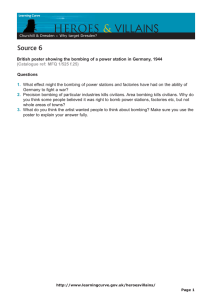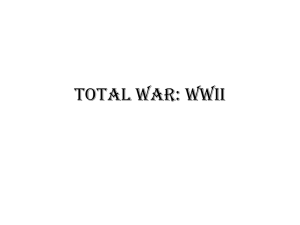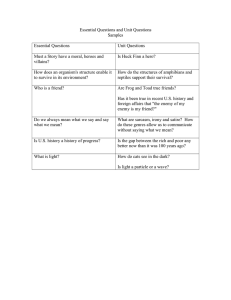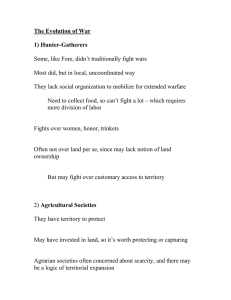war n peace 3 eng
advertisement
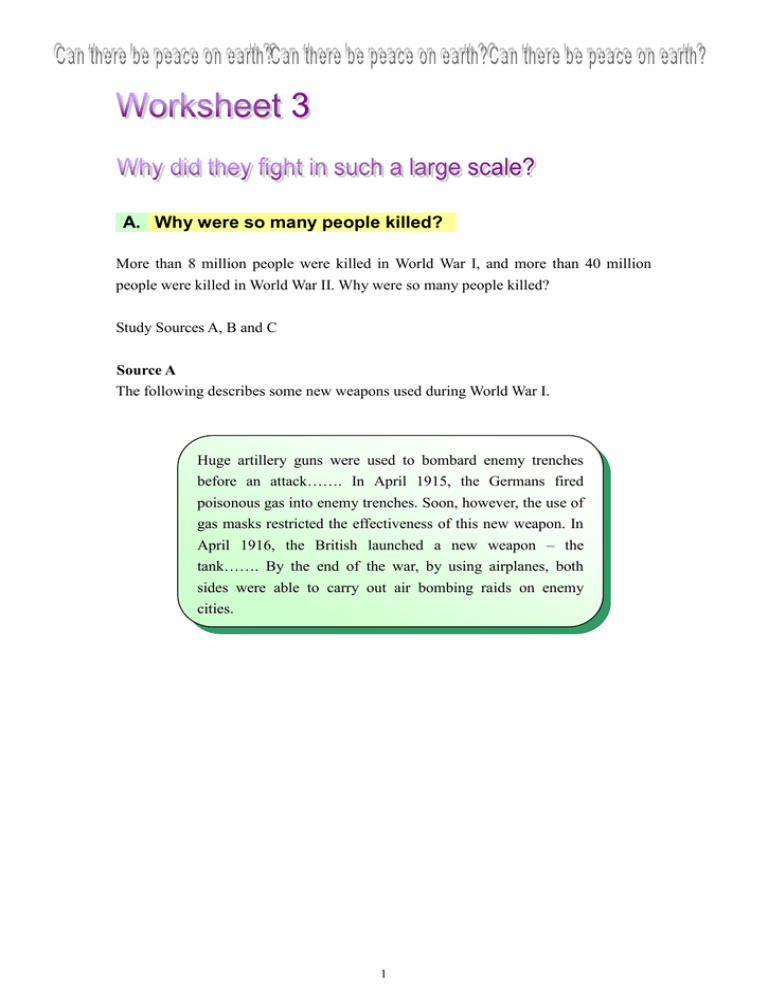
A. Why were so many people killed? More than 8 million people were killed in World War I, and more than 40 million people were killed in World War II. Why were so many people killed? Study Sources A, B and C Source A The following describes some new weapons used during World War I. Huge artillery guns were used to bombard enemy trenches before an attack……. In April 1915, the Germans fired poisonous gas into enemy trenches. Soon, however, the use of gas masks restricted the effectiveness of this new weapon. In April 1916, the British launched a new weapon – the tank……. By the end of the war, by using airplanes, both sides were able to carry out air bombing raids on enemy cities. 1 Source B The following describes some powerful weapons and tactics used during World War II. By the time that the Second World War (1939-45) broke out, weapons had become so advanced that the static warfare of 1914-18 could not be repeated. By 1939, tanks could easily crash through barbed wire and enemy trenches. The new tactic, first used by the Germans in their attack on Poland in September, 1939, was ‘Blitzkrieg’. This involved surprise attacks on the enemy using artillery and dive bombers, followed by the advance of tanks and paratroopers and then the infantry foot soldiers. As the war developed, aircraft were used to attack enemy cities. In the autumn of 1940, the Germans decided to launch a massive bombing raid on Britain’s cities. There had been some bombing in the First World War, but Hitler’s Blitz was on a far bigger scale. By 1941, 43,000 British civilians had been killed and 2 million made homeless. From 1942, the Allies bombed German cities. The effect of these bombing was horrific. For example, on 13 February 1945, up to 135,000 people were killed in a bombing raid on Dresden (a German city), which destroyed 80% of the city. Refer to the following website for the damage caused by the bombing of Dresden by the Allies. <http://encyclopedia.laborlawtalk.com/Bombing_of_Dresden_in_World_War_II> Source C The table below shows the armies of Europe in 1914. Countries Germany Austria-Hungary France Russia Britain Size of armies 2,300,000 1,200,000 2,000,000 3,000,000 600,000 2 Refer to Sources A and B 1. Identify the new weapons used in World War I and World War II, as shown in Sources A and B. Sources New Weapons and Tactics Huge artillery guns, poisonous gas, tanks and airplanes A B More powerful tanks that could easily crash through barbed wire and enemy trenches were used. New tactics were used. For example, Blitzkrieg, it involved surprise attacks on the enemy using artillery and dive-bombers, followed by the advance of tanks and paratroopers and then the infantry foot soldiers. Refer to Sources A, B and C 2. What do Sources A, B and C tell you about the reasons that explained why so many people were killed in 20th century warfare? Suggested answer: New powerful weapons were used in various wars. The use of new tactics, like bombing enemy cities, led to heavy civilian casualties. Many civilians were recruited into the army, leaded to heavy casualties. 3 B. Were only the soldiers killed? Study Sources A, B and C. Source A The following is extracted from N. Kelly’s ‘The Second World War’, 1989. Throughout history, warfare has led to the mistreatment of those civilians unfortunate enough to live within the areas of fighting. Often villages were destroyed and civilians slaughtered; sometimes the fighting disrupted food production and the civilians starved to death. The Second World War, however, brought changes in the way that warfare was conducted. From now on, civilians would increasingly become targets for attack. The Blitz, the Allied bombing of Germany and the US air raids on Japan, took a terrible toll in human lives. Source B The following describes the effects brought by the dropping of atomic bombs on Japan in World War II and its aftermath. In 1945 came the most important development in the history of warfare – the atomic bomb. The Japanese refused to surrender throughout July 1945. On 6 August the Americans dropped an atomic bomb on the city of Hiroshima. Almost 80,000 Japanese men, women and children died immediately. The atomic bomb carried with it a deadly after effect. Radiation sickness followed the explosion, causing many more deaths than the bomb itself. A second bomb was dropped three days later on Nagasaki causing around 40,000 deaths, which were later matched by deaths from the after effects. Even today the grandchildren of the survivors of Hiroshima and Nagasaki can suffer birth defects. 4 Source C The table below shows the number of women involved in uniformed services during World War II. Uniformed services Number of women involved 1. Auxiliary Territorial Service 198,000 2. Land Army 30,000 3. Civil Defence 375,000 4. Armed Forces 470,000 Refer to Sources A, B and C. Do you think the soldiers were the only ones killed in 20th century warfare? Support your answer with evidence from Sources A, B and C. Were only the soldiers killed? answer.) Yes / No (Circle the correct Evidence Villages were destroyed and civilians being slaughtered from Source happened very often. Sometimes the fighting disrupted food A production and the civilians were starved to death. New tactics like Blitz and bombing of enemy countries were used in World War II, civilians increasingly become targets for attacks. Evidence Atomic bombs were dropped on two Japan cities, leading to from Source heavy civilian casualties. The after effects of the atomic bombs B also led to the similar number of deaths. Evidence During World War II, women were mobilized to join some from Source uniformed services. Heavy casualties were reported. C 5 C. What happened to the children when the world was at war? When World War II broke out, the British government evacuated children from the danger areas of the major cities to the countryside. Parents did not know where their children were going. The government told the parents that their children would be well looked after. Study Sources A, B and C. Sources A, B and C are extracted from the memoirs of several Second World War evacuees. Source A Everything was so clean in the room. We were given face flannels and tooth brushes. We’d never cleaned our teeth until then. And hot water from a tap. And there was a lavatory upstairs. And carpets…… And clean sheets. This was all very odd. I didn’t like it. It was scary. Source B The woman said, ‘Here’s your meal’ and gave us some bread and water. Now we’d been in a rich woman’s house……. What we later found out was that the woman hated kids and was doing it for the extra money. Source C I thought it was a Sunday school outing down to the sea-side. And I looked out of the bus window and I saw my mother crying outside. I said to my brother, ‘What’s mummy crying for?’ and my brother said, ‘Shut up!’ 6 Source D Refer to the following websites for the information on daily life of British children and letters during World War II. <http://www.bbc.co.uk/history/ww2children/index.shtml> <http://www.learningcurve.gov.uk/homefront/evacuation/> Using Sources A, B, C and D, write a paragraph about how evacuees felt about what was happening to them. Students should reflect in their answer the negative psychological feeling of evacuees towards the following circumstances, e.g. 1. fear of the current situation, feeling uncertain and uneasy towards the future 2. the very difficult situation at that moment Reference: Alan Brooks-Tyreman, Jane Shuter & Kate Smith. Digger Deeper 4: The Twentieth Century World. Spain: Heinemann, 2000. Steven Waugh. Essential Modern World History. UK: Nelson Thornes, 2001. Nigel Kelly & Martyn Whittock. The Twentieth Century World. HK: Heinemann, 1995. 7

